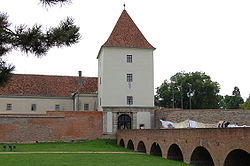Sárvár
| Sárvár | ||
|---|---|---|
 |
||
|
||
| Location of Sárvár | ||
| Coordinates: 47°15′15″N 16°56′08″E / 47.25415°N 16.93545°E | ||
| Country |
|
|
| County | Vas | |
| Area | ||
| • Total | 64.64 km2 (24.96 sq mi) | |
| Population | ||
| • Total | 15,651 | |
| • Density | 242/km2 (630/sq mi) | |
| Time zone | CET (UTC+1) | |
| • Summer (DST) | CEST (UTC+2) | |
| Postal code | 9600, 9609 | |
| Area code(s) | 95 | |
Coordinates: 47°15′N 16°56′E / 47.250°N 16.933°E
Sárvár (German: Kotenburg, Rotenturm an der Raab, Slovene: Mala Sela) is a town in Hungary in Vas.
Sár means "mud" in Hungarian, and vár means "castle". The latter is a common ending for settlement names.
Through the Nádasdy family, the castle of Sárvár, now called Nádasdy Castle, played a significant role in the progress of Hungarian culture in the 16th and 17th centuries. The first Hungarian book, The New Testament of 1541, was printed here. The knight's hall of the castle is decorated with the battle scenes of Lord Chief Justice Ferenc Nádasdy (married to the notorious Elizabeth Báthory) and with scenes from the Old Testament.
The Nádasdy Castle and estate later became a property of the kings of Bavaria, and the former King Ludwig III died there in 1921, three years after being deposed. During the Second World War, the castle was used as the retreat of Ludwig's grandson Prince Albert of Bavaria.
The population of the town lying on the banks of the River Rába at Kemeneshát is nearly 16,000. The town has become a tourist centre of international renown.
The most outstanding sights include: the arboretum (a nature reserve), the neo-Classical Lutheran church and the Roman Catholic church, the park forest and the Csónakázó (= Rowing) Lake. A new Thermal and Wellness bath of European standard was opened in 2002 awaiting visitors in pleasant surroundings.
...
Wikipedia


